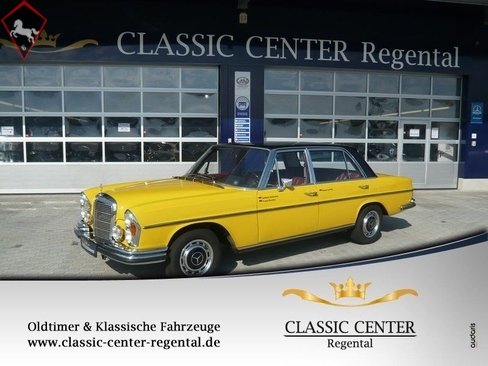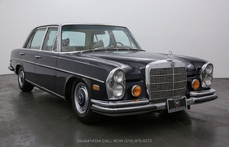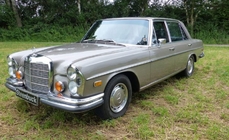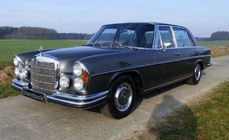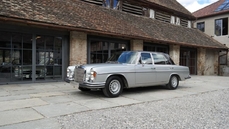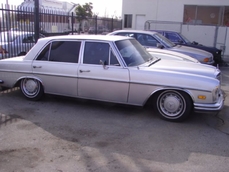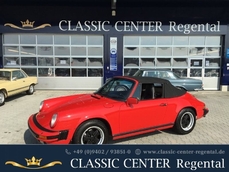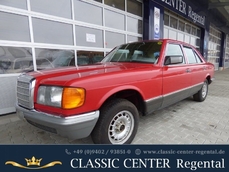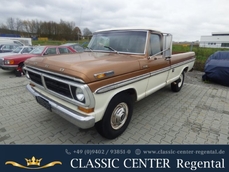Mercedes-Benz 300SEL 6.3 w109 SEL 6.3 Thurn und Taxis Originalfarbton 1969
General description :
Im März 1968 wurde das Topmodell der damaligen S-Klasse um den Mercedes-Benz 300 SEL 6.3 nach oben erweitert. Wie das bisherige Topmodell 300 SEL hatte auch der 6.3 der W-109 Baureihe eine verlängerte Karosserie und Luftfederung. Was die meisten Leute jedoch nicht wissen ist, dass der Mercedes 300 SEL 6.3 zu seiner Zeit lange die schnellste Serienlimousine der Welt war. Bestückt mit dem bereits aus dem Mercedes-Benz 600 bekannten 6, 3 Liter Achtzylinder-Motor mit 250 PS beschleunigte der Mercedes-Benz 300 SEL 6.3 in 6, 5 Sekunden von 0 auf 100 km/h und erreichte eine Spitzengeschwindigkeit von 221 km/h. Auf Basis dieses Autos entstand auch eine AMG-Variante mit bis zu 420 PS (als Rennversion), die es sogar auf eine Höchstgeschwindigkeit von bis zu 265 km/h brachte und 1971 sensationell Platz zwei beim 24-Stunden-Rennen in Spa erreichte. Dies war der Durchbruch für den heute renommierten Tuning-Betrieb! Zur Serienausstattung des Mercedes 300 SEL 6.3 gehörte auch das Automatik-Getriebe, ein 105 Liter großer Tank, ein Sperrdifferential und Halogen-Scheinwerfer. Insgesamt wurden von 1967-1972 6.526 Mercedes-Benz 300 SEL 6.3 gebaut.
Daten unseres Klassikers: **Nach Jahrzehnten wieder aufgetauchte historische Fahrzeuge aus Promibesitz sind ein "Extra Highlight" für Freunde des morbiden Charmes verwelkender Karossen. Solche Stücke, meist auf Ausstellungen dem Publikum nach Jahren und Jahrzehnten eines Daseins im Verborgenen präsentiert, haben eine besonders hohe Strahlkraft. Und jeder Betrachter ist bei der lustvollen Betrachtung bestrebt, anhand der Dellen und Beulen in der einstmals stolzen Karosse der individuellen Geschichte nachzuspüren. Was ist diesem Mobil nur passiert? Doch "lebt? es immerhin noch, und ist heute ein Zeugnis der Technik-Geschichte und historischen Herkunft. Wer beim Anblick dieser Bilder nicht voll Wehmut in Gedanken versinkt, kann nur eine Frau ohne Führerschein sein.
Wieder aufgefunden wurde auch ein Fahrzeug von Fürst Johannes von Thurn & Taxis, welches sich zu unserer Freude mit nur 93000 original Kilometern in gutem Zustand befindet. Das Fahrzeug wurde am 06.12.1968 vom fürstlichen Thurn & Taxischen Hofmarschallamt bestellt. Der Produktionsauftrag liegt uns vor. Ebenso wie die noch vorhandene Datenkarte des Fahrzeugs, ebenfalls ausgestellt auf das Fürstenhaus. Am 08.01.1969 ging die Bestellung bei Mercedes ein. Am 23.01.1969 wurde das Fahrzeug an das Fürstenhaus ausgeliefert. Man beachte den dazwischenliegenden Zeitraum von lediglich 2 Wochen in Bezug auf eine sonst eher Monatelange Wartezeit für besonders gefertigte Fahrzeuge oder hochwertige Modelle. Schließlich handelte es sich bei diesem Fahrzeug um das seiner Zeit schnellste Serien Automobil der Welt. Unser 6.3 aus fürstlichem Hause war von 1969 bis 1978 im Besitz von Fürst Johannes von Thurn und Taxis. Anschließend ging es nach München zu einem Sammler und Liebhaber. Anfang der 90er als die Preise von Oldtimern stiegen trennte sich der Sammler von dem Wagen. Der 6.3 landete bei einem weiteren Liebhaber für klassische Automobile. Schließlich entdeckten wir das Fahrzeug im Januar 2015 bei einem Oldtimer Liebhaber an der Nordsee. Nach etwas "euroreicher" Überredungskunst war dieser zu überzeugen dass dieses Fahrzeug zurück nach Regensburg muss.
\
https://home.mobile.de/CLASSICCENTERREGENTALGMBH#des_228173112
1969 Mercedes-Benz 300SEL 6.3 w109 SEL 6.3 Thurn und Taxis Originalfarbton is listed sold on ClassicDigest in Dr. Pfannenstiel Strasse 3DE-93128 Regenstauf by Auto Dealer for €89000.
Car Facts
Car type : Car Make : Mercedes-Benz Model : 300SEL 6.3 w109 Model Version : SEL 6.3 Thurn und Taxis Originalfarbton Engine size : 6.3 Model Year : 1969 Sub type : Sedan Location : Dr. Pfannenstiel Strasse 3DE-93128 Regenstauf
Sold
Seller Information
Sold
People who viewed this Mercedes-Benz 300SEL 6.3 w109 also viewed similar Mercedes-Benz listed at ClassicDigest
Other cars listed for sale by this dealer
About Mercedes-Benz
In the annals of automotive history, the journey of Mercedes-Benz is a tale that unfolds with the ingenuity of its founding pioneers. In the year 1886, Karl Benz crafted the Benz Patent Motorwagen, a creation that would go down in history as the world's inaugural automobile. Unbeknownst to him, this moment marked the genesis of what would evolve into the most illustrious premium car manufacturer globally. The financial underpinning of this pioneering venture, interestingly, was provided by Karl Benz's wife, Bertha Benz, demonstrating a remarkable partnership that would set the tone for Mercedes-Benz's legacy.A parallel narrative emerged not far away, as Daimler-Motoren-Gesellschaft, founded by Gottlieb Daimler and Wilhelm Maybach, entered the scene. In 1901, they unveiled their automobile under the now-famous moniker "Mercedes," meaning "godsend" in Spanish. This name was bestowed upon the car at the behest of Emil Jellinek's daughter, the distributor for Daimler-Motoren-Gesellschaft. The wheels of innovation were set in motion.
Fast forward to 1926, a pivotal year that witnessed the merger of Daimler with Benz & Cie., culminating in the birth of Daimler-Benz. The amalgamation saw the adoption of "Mercedes-Benz" as the distinguished trademark for their automobiles, fusing the legacies of two visionary entities into one.
Contrary to perceptions of conservatism, the trajectory of Daimler-Benz unfolds as a chronicle of industry firsts. From the introduction of the honeycomb radiator to the float carburetor, and the pioneering implementation of four-wheel brakes in 1924, Daimler-Benz consistently pushed the boundaries of automotive innovation. The diesel-powered Mercedes-Benz 260 D in 1936 marked the inception of diesel engines in passenger cars. The iconic Mercedes-Benz 300SL Gullwing made history as the first car with direct fuel injection, albeit the Gutbrod's tiny 2-stroke engine can claim precedence.
Safety innovations became a hallmark, with Béla Barényi's patented safety cell design in the "Ponton"-models in 1951, featuring front and rear crumple zones. The W116 450SEL 6.9 saw the introduction of the Anti-Lock Brake system (ABS), another pioneering safety feature. From the first production airbags and beyond, the legacy of "firsts" continued to be etched into the fabric of Daimler-Benz.
Over its centennial journey, Mercedes-Benz has not merely produced cars but has sculpted automotive icons. The SSKL, 710 SSK Trossi Roadster, 770K Grosser, 540K Spezial Roadster, 300SL Gullwing, w100 600 Pullman, w111 280SE 3.5 Flachkühler, w113 230SL Pagoda, w109 300 SEL 6.3, and w201 2.3-16 Cosworth stand testament to the brand's commitment to engineering excellence.
The roaring Silver Arrows, or "Silberpfeile," including the W 25, W 125, W154, W165, and W196, created a legacy of dominance on the racetrack. These machines were not merely cars; they were expressions of precision, speed, and an indomitable spirit that left their competitors in the dust.
As Mercedes-Benz marches into the future, it does so not just as an automaker but as a custodian of a legacy, a torchbearer of innovation, and a beacon of automotive excellence. The road ahead is sure to witness the continued fusion of cutting-edge technology, timeless design, and an unwavering commitment to setting new standards in the world of automobiles.
One luminary figure who left an indelible mark was Béla Barényi, often heralded as the "father of passive safety" for his pioneering work in safety engineering. His patented safety cell design, featuring front and rear crumple zones, became a hallmark of Mercedes-Benz's commitment to occupant safety, setting new standards that reverberated throughout the automotive world.
Moving through the chronicles, the collaborative genius of Wilhelm Maybach, alongside Gottlieb Daimler, laid the foundation for Daimler-Motoren-Gesellschaft. Their innovations not only birthed the first Mercedes but established a culture of relentless pursuit of technological excellence that remains integral to Mercedes-Benz's DNA.
In the post-merger era of 1926, Ferdinand Porsche emerged as a prominent figure within Mercedes-Benz. His work on the Mercedes-Benz S-Type, a supercharged race car, garnered acclaim and set the stage for a legacy that extended far beyond the marque. Porsche's impact would later extend to his eponymous company, but his influence at Mercedes-Benz during those formative years was pivotal.
As the 20th century progressed, the legendary Rudolf Uhlenhaut emerged as a key figure. Uhlenhaut, an accomplished engineer and the driving force behind the iconic Silver Arrows, played a crucial role in Mercedes-Benz's dominance in motorsports. His engineering prowess and attention to detail were instrumental in creating some of the most formidable racing cars of the era.
In the latter half of the century, figures like Bruno Sacco, the head of design at Mercedes-Benz from 1975 to 1999, left an indelible imprint on the brand's aesthetic identity. Sacco's design philosophy, characterized by clean lines and timeless elegance, shaped iconic models like the W126 S-Class and the W201 190E, solidifying Mercedes-Benz's reputation for luxury and sophistication.
The narrative would be incomplete without acknowledging the contributions of engineers like Hans Scherenberg, whose leadership in the 1970s ushered in a new era of technological innovation at Mercedes-Benz. Scherenberg's tenure saw the development of groundbreaking technologies, including the Anti-Lock Brake system (ABS) and the introduction of airbags in production cars.
